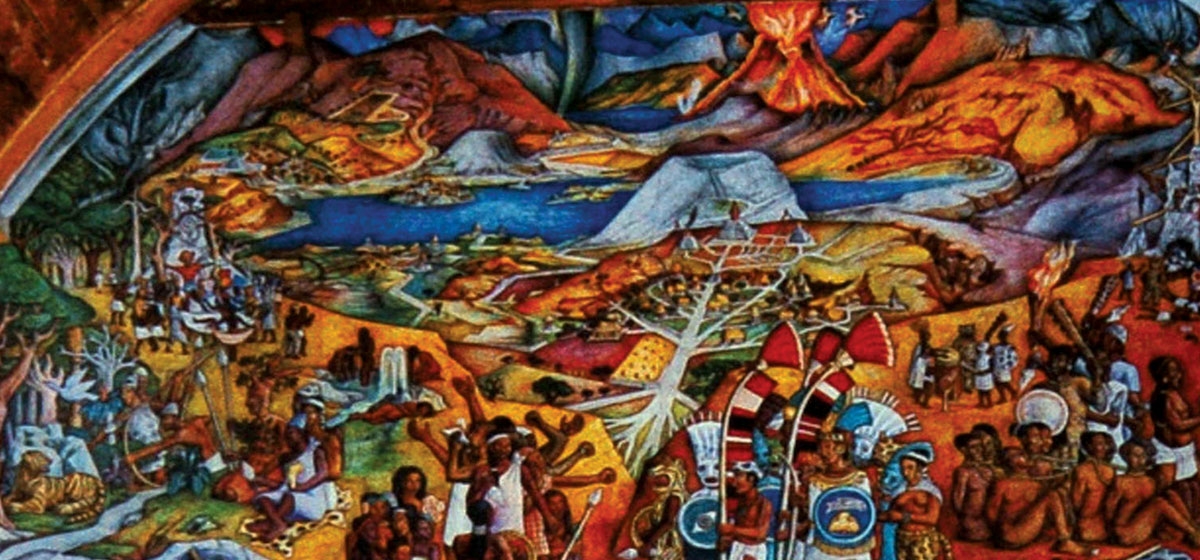
The increasingly popular genre of creative nonfiction has taken a new turn with the publication of “Shadows on a Wall: Juan O’Gorman and the Mural at Patzcuaro” by Hilary Masters (University of Pittsburgh Press, 2005, $24.95). This book-length essay combines fact and fiction with artistic metaphor, autobiography and imaginative technique to describe an episode from Pittsburgh’s past in a work that will delight some with its innovation and confound others.
Masters, the author of eight novels, two volumes of short stories and a memoir, is a professor of English and creative writing at Carnegie-Mellon University. While visiting Patzcuaro, Michoacan, Mexico, in 2000, he happened upon a vivid mural in the village library depicting the history of the region. Impressed by the mural’s scale and scope, bold coloration and imagery, and curious assemblage of characters, Masters launched an investigation that led, surprisingly, back to his own city.
The work was completed in 1942 by a Mexican Marxist with the incongruous name Juan O’Gorman, an artist and architect allied with Diego Rivera and his creative circle. Not by a curious coincidence, it was the ultimate result of an ill-fated venture sponsored by none other than department-store magnate Edgar Kaufmann, the merchant prince of Pittsburgh.
A civic leader and patron of the arts best remembered for commissioning Fallingwater, Kaufmann invited O’Gorman to Pittsburgh in 1940 to decorate the walls of the Young Men’s & Women’s Hebrew Association in Oakland, of which he was president. Although O’Gorman and his wife, Helen, spent five months in Pittsburgh, the project was “deferred” and the murals were never realized. The couple returned to Mexico, where the Patzcuaro project later emerged, funded by Kaufmann as a sort of consolation commission.
No official explanation was recorded for the deferment of the YM&WHA project, but one has only to view the surviving sketches of O’Gorman’s designs to conclude that he was sent packing. In stark contrast to the celebrated murals by J.W. Alexander in the neighboring Carnegie Museum, which romanticize the history, sweat and smoke of the region, O’Gorman’s depictions of the same subjects are replete with images of hypocrisy and greed, and mock the notions of charity and social reform. We see, for instance, the Founding Fathers posing proudly while money is exchanged behind their backs. Legendary local capitalists Mellon, Carnegie, Frick, Westinghouse and others are identified as “The Kings” of a wretched and polluted plutocracy. Not one for subtlety, O’Gorman went as far as to feature a roll of bathroom tissue prominently above one tableau, and an open toilet in another.
That sort of art may have been all the rage among O’Gorman’s set south of the border, but it wouldn’t play in Pittsburgh, particularly in an organization dedicated to the moral development of youth on the eve of World War II. Kaufmann, for all his avant-garde pretensions, was at heart a booster, not a knocker, in the best tradition of his hometown. And so on to provincial Patzcuaro, where O’Gorman adapted his themes of exploitation and injustice to Mexican history on the walls of the Biblioteca Gertrudis Bocanegra.
It’s an interesting story, as far as it goes, but it doesn’t go very far. Despite his research, Masters was unable to produce any further information about the episode except for one tantalizing report of the O’Gormans’ arrest on a charge of suspected espionage for sketching a bridge! O’Gorman himself scarcely mentioned the visit in his autobiographical notes, and Kaufmann left no paper trail. Yet the author feels compelled to paint a bigger picture — literally. “I will imitate O’Gorman and fabricate a mural,” he announces and then endeavors to transform the anecdote into the literary equivalent of O’Gorman’s Mexican masterpiece.
The appealing symmetry of such an effort is evident — a project originating in Pittsburgh is realized in Patzcuaro, where it in turn inspires a project published in Pittsburgh. But the story of Juan O’Gorman and the “Jewish Y” is essentially a vignette, and it is quite a stretch to make it fit the frame of a mural. Five months in the Smoky City is hardly comparable to the entire history of Michoacan from Creation through the 20th century. There is no evidence of any of the violence, treachery, pathos or passion that make the Patzcuaro project so powerful, and Masters searches in vain for some source of dramatic tension, speculating about sexual motives and intrigues. “Has that wall in Patzcuaro become so cumbersome for me to carry off that I must satisfy my looting with scandalous trinkets?” he wonders. “How much more easy to throw Liliane [Kaufmann] and Juanito in the sack.”
The author frequently resorts to fiction to steer the story in an engaging direction, fabricating scenes and dialogue. “To be perfectly honest,” he confesses, “I must invent some of this account; make up circumstances and rooms and the images that move within them as I pilfer a history that does not belong to me, inevitably leaving clues of myself behind.” He is, however, assiduous in creating parallels between the components of the Mexican mural and the Pittsburgh story. O’Gorman included in his work an assortment of historical characters in various arrangements — conquerors, clerics, insurgents — and Masters does too: the Kaufmanns are found hosting the O’Gormans and the Alvar Aaltos at a fictitious dinner party in Frank Lloyd Wright’s Fallingwater; Leon Trotsky, Delores Del Rio, Frida Kahlo and Edgar, junior (lower case, as he preferred) are all present at a gathering in the studio O’Gorman designed for Diego Rivera.
The mysterious rites of the ancients are depicted in Patzcuaro, so Masters provides his readers with the equivalent: a glimpse of the social mores of 1940, in both the tango-dancing set of artists and revolutionaries in Mexico and the cocktail-sipping social circles of Pittsburgh. Even the grotesque elements that punctuate the Mexican work — clown, dwarf, dog and skeleton — have literary counterparts in caricatured cameos and incidental horrors. There’s Kaufmann striding about his property in lederhosen; mincing, effete “junior” slavering over O’Gorman; Trotsky murdered with an ax to the head; O’Gorman poisoned, shot and hanging from a tree in his 1982 suicide.
O’Gorman inserted written text in his visual work as labels and statements of his political philosophy. “Asi es la vida (such is life)” reads one banner beside a scene of exceptional cruelty. Another forecasts an uprising in the native population that will liberate it from the chains of oppression. Masters likewise editorializes, providing abundant — arguably excessive — commentary, not on his politics, but on the creative process. “Now what am I doing,” he wonders, “rummaging through the bits and pieces of these lives, holding up one item with another to make a match — to test the sterling of it? When I have come across an authentic fragment, say, a description of an event, I have shamelessly stuffed it into the pack, passed it off as dialogue or even a scene!” And elsewhere: “I have only put these [fragments] into different settings to enhance their value at the risk of obscuring their origin. Isn’t that what Juan O’Gorman did on that wall in Patzcuaro? Isn’t this the process called art?”
Because O’Gorman included a portrait of himself and his wife on the wall in Patzcuaro, Masters brings himself directly into the picture through first-person narrative and references to his own family and friends. He presumes to understand and know what O’Gorman was thinking because both men were raised in households dominated by overbearing Irish authority figures; he claims to know Helen O’Gorman because she reminds him of his mother. We learn a lot about his steely grandfather, Tom Coyne, and more than is necessary about the infidelities of his famous father, poet Edgar Lee Masters.
Most significantly, the components of Masters’ “mural” are offered in a desultory manner intended to mirror O’Gorman’s construction. Describing the Patzcuaro work, the author writes, “A narrative winds down the side of the history it portrays on diagonal planes like the turns and slants of a mountain road, and the participants in this story step down these inclines. On either side of this parade, as if in arroyos by the side of the road, incidental scenes contribute subtext to the contingents passing by.” Masters, therefore, winds discursively through his own creation from one subject to the next, as a scene prompts an association, recalls a memory, or inspires a flight of fancy.
He touches on a wide variety of tangential topics including, but by no means limited to: the contents of Kaufmann’s department store; baseball at Forbes Field; Rivera’s mistresses; Benno Janssen’s architecture; Marlon Brando in “Viva Zapata!”; Graham Greene’s “The Power and the Glory”; global franchising; Wendell Wilkie’s presidential-campaign funding; John Kane’s art; terrorism and security after September 11; Pennsylvania flora and Hitler’s nephew.
Imitation may be the sincerest form of flattery, but it is no guarantee of success. Despite the author’s faithful adherence to the artist’s forms, the powerful, dynamic sensation created by O’Gorman’s mural does not translate as successfully into its literary counterpart. Readers may indeed feel overwhelmed, as Masters did in Mexico, but it is likely to be from the effort of processing the sheer volume of information and description thrust upon them in the space of 140 pages. Unlike a mural, a book cannot be taken in at a glance, and must necessarily be absorbed piecemeal. What flows in the fresco feels choppy in print, and the numerous asides intended to enrich the story are instead distracting and confusing.
“At times,” Masters notes, “I felt smothered by information I could not assimilate nor put into a useful pattern of perception. The depression of a single key can dilute the most virtuous concentration so that the inquiry overwhelms the subject — even becomes the subject. We become the victims of our own cleverness.”
This cleverness, which in the imaginative concept and artful construction of the book is its great strength, is also, in excess, its main weakness. In the pursuit of artistic effect, Masters casts off both conventional narrative structure and scholarly procedure as bourgeois constraints, while admitting that “this history deserves the judicious handling of a seasoned scholar, the keen eye of a historian far more scrupulous than the glance of my raffish tailoring.”
Like O’Gorman in Pittsburgh, Masters goes too far, in content as well as style. Just as there was too much of the artist in his YM&WHA work — too much of his radical politics and foreign perspective — there is too much Hilary Masters — his personality and personal history — in a book that purports to be about Juan O’Gorman. Why, one wonders, didn’t Masters, an accomplished, prize-winning writer of fiction, write “Shadows on a Wall” as a novel?





